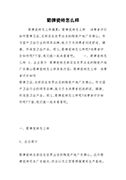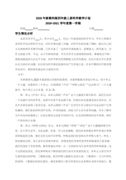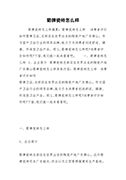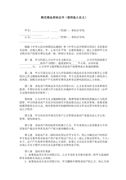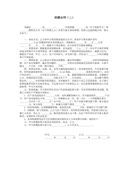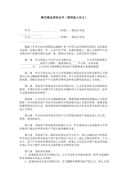《牛津小学英语》教案(精选20篇)一年级英语教案
《牛津小学英语》教案(精选20篇)
《牛津小学英语》教案 篇1
一、教学内容
part a,b,c,e2,e3
二、教学目标
1. 学会唱字母歌。
2. 能在熟练掌握本单元所学单词、句型基础上,巩固复习3a中文具类,动物类,交通工具类,食品类单词。
3. 能将本单元句型熟练地运用到日常交际中。
4. 能在教学活动中,感受到成功和快乐,增加学习英语的兴趣和自信。
三、教学重点
1. 能将本单元句型熟练运用到交际中。
四、教学过程
step 1. greeting.
learn to sing the song ”a b c” together.
step 2. revision
1) have a dictation
可以适当增加听音填字母的项目,促使学生尽快熟悉简单的读音规律,为记忆单词打下基础。
2)小组竞赛,说出文具类词语。
3) game. 模仿教材e2中形式进行。句型可以略作调整。what’s this in my school bag? it’s a …
规则:
1. 四人小组进行游戏。
2.摸物品,每人2次机会,答对的同学可以将物品放在自己的位置上。
3.最后物品最多的同学即是赢家。
4.若有同学用中文,失去一次猜谜机会。
step 3. consolidation and practice
1. t: you did a good job. i’d like to buy a toy for my nephew. would you like to go with me? guess, what can you see in the toy shop?
复习动物类,交通工具类,家具类词汇。
2. 情境一,示范对话,并让学生跟读。
a: hello, … how are you?
b: fine, thank you. and you?
a: i’m fine , too. let’s go to the toy shop by bus.
b: ok, let’s go.
a: here we are.
b: look, what’s that on the door?
a: it’s a …
b: oh, i see. come here, … what’s this on the desk?
a: it’s a …
b: how nice!
a: a …, please.
c: ok, here you are.
…
3. 小组合作,看图编对话。
4.情境二,买完玩具,一起去kfc吃了点东西。正巧遇到了一位外国人,相互自我介绍后,又相互请教了食品名称。
示范:(根据本班实际情况,选择是否继续示范)
a: hi, my name is … what’s your name?
b: my name is …i’m an english … i’m from …
nice to meet you.
a: nice to meet you, too. excuse me, what’s this in english?
b: it’s a packet of chips. what’s this in chinese?
a: han bao.
b: oh, i see. thank you.
5. 同桌模仿例子,编新对话。(师将提供的食品图片贴在黑板上)
step 4. homework
1. 跟磁带,大声朗读本单元课文五遍。
2. 提供图片及句子,请学生给句子排序,变成对话。
注意点:
1. 要在充分复习后,给学生创设表达的机会。
2. 情境创设要简洁,大情境中设置若干个小情境。
3. 运用前有示范。若学生情况好,可以逐渐放手。
《牛津小学英语》教案 篇2
Unit 8 Open Day胡埭中心小学 王菁菁一、教学内容:《牛津小学英语》4B第八单元第一课时 二、教学目标 :1、 能听懂、会说,会读,会拼写单词a chair, a blackboard, a picture, a bookcase, a classroom, an office, a playground 。2、 能听懂、会说,会读,会写句型 There's a / There are some ...in/ on/ near the ... 3、 熟悉歌曲 In the classroom 。三、教学重点和难点: 1、 能听懂、会说,会读,会拼写单词a chair, a blackboard, a picture, a bookcase, a classroom, an office, a playground 。2、 能听懂、会说,会读,会写句型 There's a / There are some ...五、课前准备 教具准备 :本课课件 及磁带录音机。 六、教学过程 Step1. Free talk: 1.师生用Good morning/afternoon. How are you?互相问候。 2.出示课件,看图片复习学过的单词(食物类、水果类、职业类、家庭用品类)。重点复习本课中的复现单词:a computer, a chair, a bookcase. 3.复习句型:Let's go to the library. Great! How do we go there? Shall we go to there by bus? OK.练习"there" ,并书写。 4. Let's sing the song 《The wheels on the bus 》,(出示课件音乐,并在每个地点类单词图片出现前播放)。 Step2. Presentation and practice 1、 出示library的图片。 T: Look at my picture. 出示单词picture 并领读 S: 跟读. T:(指图片) What's this ? S: It's a library. T: What can you see in the library? S: I can see a picture , a computer and some bookcases. 2、出示课件歌曲《Wheels on the bus 》T:(出示office的图片)What's this ? S: ……T: It's an office .. 出示单词 office 示范朗读 S:跟读 T:What can you see in the office ? S: I can see a computer .T: So you can say: There is a computer. Can you say like me? 出示句型:There is a/an ……Can you say like me? S: There is a computer.There is a ... S:造句练习。 3、听音乐,做动作,出示classroom的图片 。T: What's this ? S: It's a classroom . 出示单词 classroom 并领读 S:跟读 T: What can you see in the classroom?出示blackboard 的图片。 S: There's a blackboard . 学生造句练习……T: 出示复数句型There are some …… S: (在教师帮助下 ) There are some desks . 学生学说并做造句练习。4、同法教 a playground, a music room. Step3 A short break 1、Enjoy a song 欣赏本课的歌曲 In the classroom 2、A game" Magic ears” 游戏规则:教师说本课单词,不发出声音,仅让学生看口型,学生根据教师口型猜测是什么单词。 Step 4. Learn to say 1、在黑板上写出课题Unit8 Open day 并领读 2、出示本课单词图片。学生看图说单词。 3、T:(示范)This is an office. There is a/ an... on/ in the... There are some ...on/ in the ... Can you say something like that? S:模仿教师练习句型。 Step5 Consolidation 1、看图说话比赛 ,练习书上Part.C教师出示书上图片。 学生分两大组比赛哪组说的多,说的好。 用句型: There is /are.... in / on the... Step 6 Homework 1、听磁带,跟录音读对话。 2、单词抄写,各三遍。 附板书: Unit 8 Open Day There is a /an…… There are some ……
《牛津小学英语》教案 篇3
一、教学内容
part a,b,c
二、教学目标
1.能熟练地听、说、读本单元所学单词、句型。
2.能初步将本单元句型运用到日常交际中。
3.能在教学活动中,感受到成功和快乐。
三、教学重点
1.能初步将本单元句型运用到交际中。
四、教学过程
step 1. greeting.
(日常问候语)
step 2. revision
1) free talk
师出示与本课内容相关的文具残缺图片若干,操练句型:
what’s this/that in english? 及其应答
2) 学习歌曲what is this in english?师示范后,学生跟唱。
3) 鼓励学生挑选喜欢的图片,小组创作新歌词,并集体演唱。
step 3. activity
1.i can draw a …跟着老师画文具类简笔画
2.listen and point.
3.listen and color.(师提供颜色,生自己涂色)
4.让学生将这些新文具摆放到合适的地方。建议:in the pencil box/desk/book; on the pencil box/desk/book等
5.师示范新对话,并让学生跟读。
如:
a: come here ,…
b:all right.
a: excuse me, what’s this on your book.
b: oh, it’s my tape.
look, it’s new.
it’s green and white.
it’s from my dad.
it’s on my book now.
6.学生以小组为单位,编新对话,并表演。
step 4. homework
1.将课上自己编的歌曲歌词以小报的形式展示出来。
2.口头向父母介绍自己的文具。
注意点:
1.活动课不能搭建花架子,所设计活动要紧紧围绕教学重点。
2.活动过程中要用语言,不仅用本单元,更要考虑到前面的知识联系。
活动资源要用足,用好。
《牛津小学英语》教案 篇4
一、教学内容
单元小练习
二、教学目标
1、 熟练掌握本单元的(三会、四会)单词、词组、句子及对话。
2、 运用已有语言知识解决问题。
3、 通过难度适中的适量小练习,帮助学生进一步了解自身学习状况,以促进以后的学习。
三、教学重点
引导学生学会发现本单元知识的薄弱环节,以便及时调整教学策略。
四、教学过程
step 1. greeting
sing an english song.( what is this in english?)
step 2. revision
1. 师提供本节课的话题“my stationery”,鼓励学生围绕此话题与教师或同学进行交谈。
2. 生齐读a、b部分,鼓励学生总结本单元学到的知识。
1) 一些文具类的单词,并初步接触了它们的复数形式。(knife是特例)
2) 会默写3个四会单词
3) 介词in/on, 借助这两个词语,我们可以表达物品的位置。让学生举例。
4) 初步掌握my/your/his/her +名词,表示某人的东西。
5) 用途很广的几个交际用语: come here. excuse me. oh, i see.
6) 询问物品的英文名称或中文名称时,我们可以用句子……
7) 询问近处或远处东西时,可以用句子……
3、完成小练习
小练习内容如下:
一、 请读一读下面的英语,你能写出对应的中文吗?
1. storybook_______ 2. copybook_______ 3. knife_______
4. toy train_______ 5.tape_______ 6.stapler_______
7. school bag_______ 8. in english_______ 9. in chinese_______
10. my pen_______ 11. your ruler_______ 12. his rubber_______
13. on the bookcase_______ 14. in the school bag_______
二、看图写单词
考察book, tape, bag.(可以适当增加1-2个与它们发音类似的单词)
三、模仿例子写复数
for example: a toy train------some toy trains
选择本课及以前学过的部分单词,其中可以设两个不规则的单词,数量控制在10个以内。
四、根据所给情境,从方框中选择合适的句子:
主要考察交际用语的掌握情况。
如:1. 需要打扰别人时,可以说:
2. 当你弄明白一件事情的时候,可以说:
3. 请某人过来,说:
4. 做错事情时说:
…
五、提供图片和句子,让学生给图中人物配上句子,并写出中文翻译。
建议: 对话控制在4句内,以本单元重点句型为训练重点。
注意点:
1. 让复习课不要成为老师的个人演讲。不要低估学生的三言两语,耐心的引导他们学会梳理知识,培养学习能力。
2. 练习内容的设计不同考试,目的重在单元基础,不可以难、偏、怪。学生通过练习可以客观的了解知识的掌握情况,老师也可以为下面的教学找准目标。
《牛津小学英语》教案 篇5
一、教学内容
part a
二、教学目标
1. 能初步熟练地听、说、读上节课所学单词、句型。
2. 能听懂,会说,会读句子:
a) come here.
b) excuse me.
c) oh, i see.
3、能听、说、读、写单词bag, book ,tape
4、初步学会用英语有礼貌地询问物品的名称。
三、教学重点
1. 能正确朗读课文。
2. 能科学记忆四会单词。
四、教学过程
step 1. greeting.
t:good morning.
ss: good morning.
t: how are you?
…
step 2. revision
1) free talk
师示范: excuse me, what’s this/that in english?
it’s a …
领读excuse me。师生,生生间相互问答。
2)小诗复习单词
a crayon, a crayon.
it’s in the desk.
a knife, a knife.
it’s on the chair.
鼓励学生自己边摆文具,边创作小诗。
3) 完成教材e1听力练习。
4) look at these words carefully.
bag , cat , fat , dad
book , look , cook , hook
tape , name , kate
大声读完后,让学生试着总结后,集体背诵单词。
step 3. presentation
a: come here, …
b: all right.
a: excuse me, what’s this/that in/on the box?(利用遮盖等方式创设信息差,提高语言运用的真实性)
b: it’s a …
a: oh, i see. thank you.
b: that’s ok.
step 4. learning new materials
1. 领读新句子:come here,oh, i see.
2. 看课文插图,回答问题。
1) who are they?
2) where?
3) what color is the …?
3. 分两次听磁带,回答问题。
1) what’s that on the desk?
2) what’s this in english?
4. 跟读课文两遍。
5. 小组读课文。
6. 分角色朗读课文。
step 5. consolidation and practice
1. 鼓励学生看着课文插图,给图中人物配音。
2. 结合练习册内容,做适当练习。
step 6. homework.
1. 跟磁带大声朗读课文a,b五遍。
2. 抄写四会单词四遍,并背诵。
注意点:
1.课文朗读时间应尽量长一点,不能走过场,或寄希望于课后。
2.复习环节要方式多样化,扎实操练。
课文处理环节要注重教材资源利用。
《牛津小学英语》教案 篇6
教学内容: 《牛津小学英语》4b第八单元第一课时
二、教学目标 :
1、 能听懂、会说,会读,会拼写单词a chair, a blackboard, a picture, a bookcase, a classroom, an office, a playground 。
2、 能听懂、会说,会读,会写句型 there's a / there are some ...in/ on/ near the ...
3、 熟悉歌曲 in the classroom 。
三、教学重点和难点:
1、 能听懂、会说,会读,会拼写单词a chair, a blackboard, a picture, a bookcase, a classroom, an office, a playground 。
2、 能听懂、会说,会读,会写句型 there's a / there are some ...
五、课前准备
教具准备 :
本课课件 及磁带录音机。
六、教学过程 step1. free talk:
1.师生用good morning/afternoon. how are you?互相问候。
2.出示课件,看图片复习学过的单词(食物类、水果类、职业类、家庭用品类)。
重点复习本课中的复现单词:a computer, a chair, a bookcase.
3.复习句型:let's go to the library. great! how do we go there? shall we go to thereby bus? ok. 练习"there" ,并书写。
4. let's sing the song 《the wheels on the bus 》,(出示课件音乐,并在每个地点类单词图片出现前播放)。
step2. presentation and practice
1、 出示library的图片。 t: look at my picture.
出示单词picture 并领读 s: 跟读. t:(指图片) what's this ? s: it's a library. t: what can you see in the library? s: i can see a picture , a computer and some bookcases.
2、出示课件歌曲《wheels on the bus 》 t:(出示office的图片)what's this ? s: …… t: it's an office .. 出示单词 office 示范朗读 s:跟读 t:what can you see in the office ? s: i can see a computer . t: so you can say: there is a computer. can you say like me? 出示句型:there is a/an …… can you say like me? s: there is a computer. there is a ... s:造句练习。
3、听音乐,做动作,出示classroom的图片 。 t: what's this ? s: it's a classroom . 出示单词 classroom 并领读 s:跟读 t: what can you see in the classroom?出示blackboard 的图片。 s: there's a blackboard . 学生造句练习…… t: 出示复数句型there are some …… s: (在教师帮助下 ) there are some desks . 学生学说并做造句练习。
4、同法教 a playground, a music room.
step3 a short break
1、enjoy a song 欣赏本课的歌曲 in the classroom
2、a game" magic ears” 游戏规则:教师说本课单词,不发出声音,仅让学生看口型,学生根据教师口型猜测是什么单词。
step 4. learn to say
1、在黑板上写出课题unit8 open day 并领读
2、出示本课单词图片。学生看图说单词。
3、t:(示范)this is an office. there is a/ an... on/ in the... there are some ...on/ in the ... can you say something like that? s:模仿教师练习句型。
step5 consolidation
1、看图说话比赛 ,练习书上part.c 教师出示书上图片。 学生分两大组比赛哪组说的多,说的好。 用句型: there is /are.... in / on the...
step 6 homework
1、听磁带,跟录音读对话。
2、单词抄写,各三遍。
附板书:
unit 8 open day
there is a /an……
there are some ……
《牛津小学英语》教案 篇7
一、教学内容
part b, c
二、教学目标
1. 能听懂,会说,会读单词:storybook, copybook, knife, toy train, tape, stapler, school bag, , in, on, in english
2. 能听懂,会说,会读句子:
a) what’s this/that in /on the …?
b) what’s this/that in english?及其应答句。
3、初步学会用英语询问物品的名称。
三、教学重点
1. 能正确朗读以下单词:knife, tape, stapler, crayon
2. 能正确区分this/that, in/on, tape/tap
四、教学过程
step 1. greeting.
t:happy new year to you all, boys and girls.
ss: the same to you.
t: how is your vacation?
s1: good.
s2: not so good.
…
step 2. revision
t: look, this is my …
it’s +color. how nice!
look, that’s his/her …
示范后,学生操练。
step 3. presentation
t:(指着课本)what’s this in english?
s1: it’s a book. (引导回答)
t: where?
s1: on the desk. (引导回答)
领读in english,on/in
示范后,生生利用身边的文具,操练新句型
step 4. learning new materials:
1. 将要学习的新单词实物放进袋子里,让学生随意挑选后,主动发问:what’s this/that in english?可求助老师,也可以求助同学。
2. 逐一板书新单词时,要求学生拼读。领读新单词,注重音节划分,单词构成,字母组合,新旧单词区分等方面的渗透。
如storybook, copybook ; crayon, day, bay ; knife ; toy train, boy ;tape , tap ; school bag ; sta pler
3. 游戏操练新单词。如高低声,看口形猜单词等。
4、利用图片或实物,操练单复数。a stapler? yes/no. some crayons? yes/no. …渗透复数概念,并强调knife---knives.
5.看b图说话。what can you see ? i can see a …
6.通过图片、实物、多媒体等方式创设情境,操练新句型:what’s this/that in/on the …?
step 5. consolidation and practice
1. 指导完成c部分的看图说话。
2. 条件允许的情况下,可将四段对话打印出来,让学生阅读后配对。
step 6. homework
1. 抄写b中词汇,每个两遍,中文一遍。
2. 跟磁带朗读b中词汇五遍,并拼读。
3.看图说话,自己操练c部分。
4. 准备一个自己感兴趣的物品,下节课带到课堂上。
注意点:
1. 教学内容较多,把握好时间分配,尤其是新授部分内容要予以充足的时间保证。
2. 新授单词,句子不要苛求每个学生都掌握得很熟练。
教学过程中要高频率,快节奏,充分激发学生的兴趣。
《牛津小学英语》教案 篇8
教学内容:a. listen, read and say(第三部分)
教学目标:
1、能听懂、会说、会读词汇:subject, e-mail address。
2、能听懂、会说、会读日常交际用语i hope so。
教学重点:
1、address的发音。
2、正确理解,掌握并朗读对话内容。
教学难点:能熟练演对话。
教具准备:a部分挂图、小黑板、图片、磁带、自录一段关于peter的录音。
教学过程:
step 1 warm up
1. greeting
2. free talk
上节课已布置学生准备问题,课前教师可事先检查,找出较好的问题,请2位学生提问,其他同学回答。
question:
①does liu tao want to have a postcard?
②what does liu tao want to have?
③what does liu tao want to do? …
3. revision
①全班学生集体朗读引言和第一部分对话。
②分角色背诵对话。
③四人一组分组表演对话。
step 2 presentation
1、教师在课前自录一段peter自我介绍的录音,将peter的有关情况直观、形象地展示给学生,让学生们和对话中的liu tao一起了解peter,现帮助liu tao一同向妈妈介绍peter的情况,并和liu tao的妈妈一起建议liu tao如何回信。录音内容如下:
dear friend:
i’m peter, i’m from the uk. i want a penfriend in china.
please listen to my self-introduction.
i live in london. i have a brother and a sister. i like listening to music and making model planes.
2、学生听完两遍录音后,小黑板出示准备好的问题。教师将全班学生分为四大组,每一组派出一名代表上台选择问题进行回答。
question: ①who’s peter?
②where does he live?
③does he have any brothers or sisters?
④what are his hobbies?
3、“liu tao的妈妈建议如何回信”这一部分可让学生直接打开书,四个人为一组,合作学习。
①每组中的由一个学生读对话,其余三个学生填空。
②指名读出所填内容。 ③集体订正。
step 3 consolidation
1、听录音,跟读本节课所学对话。
2、自我介绍。
游戏规则:要求学生在写自我介绍时,不提到自己的名字,将全班分为六至八组,把收上来的个人简介打乱发给每个学生,让学生通过阅读猜出作者是谁。
step 4 homework
1、听a部分录音,熟读并背诵、表演a部分对话,下节课检查。
2、全班齐读。 3、男女生分角色朗读。
4、写一篇自我介绍,下节课汇报。
板书内容:
1、课题:unit 7 a letter to a penfriend.
penfriend wanted
name: peter white
age: 12
city:
family: mum, dad, and .
hobbles:
2、
板书设计:
《牛津小学英语》教案 篇9
教学内容:《牛津小学英语》6b unit 6 f play a game g listen and repeat h sing a song.
教学目标:
1、了解字母组合ow在单词中的读音。
2、能唱歌曲will you join me?
3、熟练掌握本单元所学内容。
教学重点:熟练掌握本单元所学内容。
教学难点:了解字母组合ow在单词中的读音。
教具准备:录音机、磁带、小黑板、骰子、棋子等。
教学过程:
step1 warm up
1. greetings
2. free talk
就本单元所学的内容进行自由交谈,可采用师生间、生生间、小组间等形式进行。
step2 revision
1. 齐读e read and number。
2. 学生小组内准备朗读并表演对话。
3. 教师抽查,全班评议。
step3 presentation and consolidation
1. play a game
①教师事先布置学生根据图例,了解有关游戏规则和方法,准备好游戏工具,包括骰子和棋子。
②指导学生可在小组内开展游戏活动。
③教师抽查学生开展游戏的情况。
④教师可鼓励学生自己自创新的玩法,在游戏中进一步巩固所学知识。
2. listen and repeat
①教师让学生自己朗读单词,边读边体会字母组合ow在单词的读音。
②指导学生听录音跟读单词和句子,教师可利用图片或多媒体课件帮助学生理解句意。
③教师可指导学生朗读,也可在学生中开展朗读比赛。
④学生自己归纳整理其他例词,编写绕口令或其他句子并练习朗读。
⑤汇报结果,教师相机板书。
snowmen
snowball
row rowing
show know
snow
blow low
snowy
snowman
lower slow
slower
3. sing a song
①讲解歌词大意。
②读歌词。
③听录音。
④听录音跟唱。
step4 homework
1、全面复习本单元所学内容。
2、背诵g listen and repeat并试着归纳其它例词。
3、预习《补充习题》unit 6。
板书内容
snowball
snowmen
snowman
snowy
snow
row rowing show
blow know low
lower slow slower
板书设计:
《牛津小学英语》教案 篇10
教学内容:《九年义务教育六年制学教科书·牛津小学英语》6bunit8 part b look, read and write, 练习册part e.
教学目标:
1、通过复习,熟练掌握unit 5的四会词汇及句型。
2、熟练掌握unit8 b部分出现的句型。
教学重点:
1、熟练掌握unit5的四会单词及句型。
2、熟练掌握unit8b部分出现的句型。
教学难点:学生能根据情境自由运用语言。
教具准备:天气类词汇卡片。
教学过程:
step 1 warm up
1.greetings
2.say a rhyme “seasons”
step2 revision
1、师快速闪动unit5的词汇卡片,学生抢答。
2、听写四会单词。
play a game.
教师出示四个地名在黑板上,分别为beijing, london,newyork.,sydney, 请一名同学上台背对着黑板,老师标出所要猜的地名,猜的同学用what’s the weather like in summer / winter / autumn / spring there? 向其他同学提问,然后根据问答猜地名。
3、小组内连锁问答。
a: which season do you like best?
b: i like……
a: why?
b: because it is ….. i can……
step 3 look, read and write.
1. talk about the pictures in group.(提醒学生注意秋天里白天变短,夜晚变长)
2. try to write.
3. ask ss to give the answers
4. 小组里朗读比赛。
step 4 look, think and write.
练习册part e
t: bays and girls, do you know the weather in hang zhou? let’s look at the pictures and read the passage.
1.ss talk about the pictures .
2. try to complete.
3. ask some students to read.
4. talk about the weather in hang zhou in group.
5. 指名试着到前面介绍。
step5 homework.
模仿书上b部分的三、四两个片段或练习册e部分的片段介绍我们这里的四季情况及人们的活动,用英文写下来。
板书内容:
unit 8 review and check.
seasons: spring summer autumn, winter.
weather: warm cool sunny cloudy rainy windy
what’s the weather like ?
it’s …..
板书设计:
《牛津小学英语》教案 篇11
《牛津小学英语》6b unit5 seasons的话题主要是围绕“季节”展开,课文介绍了纽约的四个季节,课文中的这四个季节并不是按顺序逐一介绍的,而是在特定的话题下产生。课一开始,教师在free talk中与学生交流有关天气及四季的相关话题。
[教学片段一]
t: what’s the weather like today ?
s: it’s sunny day.
t: which season is it now ?
s: it’s spring.
t: which season comes after spring ?
s: summer.
t: which season is the last season ?
s: winter.
t: which season do you like best ? why ?
s: i like… because i…
free talk中的等问题,把学生引入他们感兴趣并熟知的“扬州四季”,既为学习课文中“纽约的四季”做了铺垫,也促使学生用英语主动去谈论家乡的季节,大大增强了学生的求知欲。
[教学片段二]
t: su yang’s dad is going to new york next week. but she doesn’t know the weather. who can help her?
t: what’s the weather like in new york?…
(教师提一些问题,学生听完课文对话后,回答问题)
由这一系列的问题,教师把学生带入课文引言部分的学习,在这一学习过程中,教师的话题从学生感兴趣的“summer holiday”转换成new york。但笔者认为教师完全可以改变一下free talk中最后的话题,可以先问where are you going next week? 再转换为where is su yang’s dad is going next week? can you guess?这样,自然地过渡到课文内容的学习,新旧知识点的联系就较为紧凑了。
课文教学是小学高年级外语教学的重点,也是难点。课文是教材的中心,是教授、学习语言知识和训练语言技能的综合教学材料。高年级课文的词汇量大、句型比较长。教师如何有效地让学生学习课文内容呢?教师是直接讲解课文?还是教师设计不同的练习,通过不同的方法,来逐步学习课文呢?课文内容的学习方式需要多样性。魏老师教学课文内容的方式是这样的:
一、通过“听音标号”的形式,学生初步感知课文
教师提了两个问题how long is he going there? what questions does su yang ask about ? 学生带着问题先整体听课文内容,根据课文介绍的先后顺序标序号。
通过“听音标号”这种形式,学生对课文介绍的纽约季节的先后顺序有了一个感知,对课文内容有了一个初步了解,有了一个整体的把握。
二、通过“选词填空”的形式,学生深层学习课文
学生对课文内容有了初步的感知,如何进一步加深学生对课文的理解?如何使学生了解纽约的季节里不同的天气及人们的活动?教师采取了“选词填空”的形式,学生一边仔细听课文录音,一边选词填空。考虑到学生刚刚接触课文,考虑到不同水平的学生,教师并没有让学生直接填词,而是给出了一些关于天气的词,让学生去选词填写,大大降低了难度,学生进一步理解了课文内容。
seasonweatherhotrainycoolwindycloudywarmsummerautumn spring
三、通过“缺词填空”的形式,学生再次理解课文
学生是否已经掌握了课文知识?如何来检测学生的学习效果?魏教师根据课文内容把对话改编成了一篇小短文,让学生根据所学的课文内容填空,通过这种形式,不仅检测了学生掌握课文知识的情况,同时再次让学生理解巩固了课文,更进一步地理解掌握课文知识。
su yang’s dad is going to new york . he is going to work there one year . in new york, there’s a lot of rain in . the weather in summer is
as as in nanjing. autumn is the season in new year.
it’s and . in winter it’s than in in nanjing. su yang’s dad
needs some warm clothes for winter in new year.
整篇课文的学习,教师采取了“总→分→总”的方法,及学生先从整体上把握课文,理解整篇课文的意思,然后分段学习课文,自然新授并讲解知识点,最后再进一步巩固课文。在每个教学环节的过程中,教师采取了不同的教学方法,设计了不同的练习,题目由简到难,并且题型多样,激发了学生学习的兴趣,学生做的不亦乐乎!
这一节课中,教师设计的各个环节都很巧妙,学生学习课文的方式多样,有“听音标号”的形式等。学生运用语言的活动很多,教师对课文内容教学的每一个步骤设计到位,考虑到学生知识水平,循序渐进地,运用多种练习方式,不同难度的题目,让学生学习课文。在学习课文中学生了解了语言知识,掌握了语言知识,并去运用了语言知识,符合学生的认知规律,学生感兴趣,学的轻松,教学效果好。
《牛津小学英语》教案 篇12
《牛津小学英语》5a unit 9 shapes 教学设计
丹阳市蒋墅中心小学 张亚琴
一、教学目标
1、知识目标:能听得懂,会说,会读和会拼写单词shape, shapes, a circle, a square, a diamond, a rectangle, a triangle, a star及其相应复数形式。能听得懂,会说,会读和会写句型what shape is the…?it’s a …
2、技能目标:使学生能灵活运用所学知识完成交际任务。
3、情感目标:保持学生的学习兴趣。
二、教学内容及重难点
教学内容:5a unit 9 shapes
教学重难点:能听得懂,会说,会读和会拼写单词shape, shapes, a circle, a square, a diamond, a rectangle, a triangle, a star及其相应复数形式。能听得懂,会说,会读和会写句型what shape is the…?it’s a …
三、教学过程
1、warm up ---- free talk
t: boys and girls, i like drawing pictures. do you like drawing?
s:……
2、presentation
(1)引出课题 t:i have some cards. do you have a card?(教师呈现自己做的贺卡) s: ……(教师选一张圆形,长方形的贺卡贴在黑板上)
t: there are two cards on the blackboard. let’s have a look. what’s in the card? s:……
t: there are some shapes.
teach: a shape shapes
(2) t:(指着黑板) this is a circle card.
teach: a circle
t: the football is a circle. can you see something like “the …is a circle.”(组织小组竞赛造句,表现优秀的小组贴上图形)
t:(指着黑板)what shape is it? it’s a rectangle. it’s a rectangle card.
teach: a rectangle .
t: the book is a rectangle. can you see something like “the …is a rectangle.”(组织小组竞赛造句,表现优秀的小组贴上图形)
t: i have a rectangle paper. look at me. is it a rectangle? (将长方形纸折成正方形) s: no.
t: it’s a square.
teach : a square
can you see something like “the …is a square.”(组织小组竞赛造句,表现优秀的小组贴上图形)
t: (正方形纸折成三角形)what shape is it? is it a square?
s: no. t: it’s a triangle.
teach: a triangle
(3) teach: what shape is the …? it’s a …
t: we are talking about shapes.( cai ) what shape is the …?
s:it’s a ..(课件展示两幅图片)
t:can you ask me ?
teach: what shape is the …? it’s a …
s—t: what shape is the …?it’s a …(组织小组竞赛对话,表现优秀的小组贴上图形)
s—s:what shape is the …?it’s a …
(4) say a rhyme: (拍手)
card, card, i like cards.
circle, circle, it’s a circle football.
rectangle, rectangle, it’s a rectangle door.
square, square, it’s a square clock.
triangle, trangle, it’s a triangle kite.
(5)t: look at my card. there’s a tree in the card. what’s in the tree? s:… t: some stars.
teach: a star
( cai ) guess: what shape is it? is it a star?(遮住)
teach: a diamond
3、practice
(1) ( cai ) t: do you know them?( look and say)
(2) guess game: (露一小半图)t: what shape is it?
(3)look and say:( cai ) how many …are there? there are ….
(4)公布竞赛结果:用句型 how many … are there? 汇总。
(5) exercise:
t:look, i can make a picture. there’s a triangle ,
a rectangle and two squares. can you say?
4、板书设计:
unit 9 shapes
(贺卡1) what shape is the …?
it’s a …. (小组竞赛贴图)
(贺卡2)
《牛津小学英语》教案 篇13
教学内容:
1、b部分单词:a postcard, glue, writing paper, an envelope, write a letter。
2、c部分第1、3、5幅图。
教学目标:
1、能听懂、会说和会读单词和词组a postcard, writing paper, an envelope。
2、能正确地听、说、读、写单词glue, write a letter。
3、能正确地听、说、读、写句型can i have…? what for? i want to…
教学重点:
1、能熟练地听、说、读、写单词glue, write a letter。
2、能正确地听、说、读、写句型can i have…? what for? i want to…。
教学难点:了解glue和writing paper是不可数名词。
教具准备:教师和学生都准备明信片、邮票、信封、胶水、信纸的实物,c部分挂图、图片。
教学过程:
step 1 warm up
1、 sing a song: will you join me?
2、 free talk(以将要做什么为谈话主题)
①师生交谈
t: what are you going to do this weekend/this morning/ this eneving/tomorrow afternoon?
s: i’m going to…
s: i’m going to…
…
②小组互相交谈
what are we going to do this morning/ this weekend/ tomorrow evening…?
where are we going to do this afternoon/ tomorrow morning?
step 2 presentation
1、 teach: a postcard
①t: today is my birthday, i received a postcard from my brother. do you know“a postcard”?
②教师出示明信片,领读a postcard。
③教师出示以前学过的单词a postman和a card,告诉学生a postcard是个合成词。
④师生齐读post, post, card, card→postcard。
⑤两个学生开火车操练a postcard, a postcard, i have a postcard。
⑥教师走到台下,问一位学生: can i have a postcard?引导学生回答sure. here you are。教师接着说i want to write to my brother jim。
⑦教师出示几张明信片,示意学生用句型can i have a postcard?提问,教师相机说what for?
⑧教师大体介绍what for的意思,告诉学生what for相当于why。
⑨师生,生生操练。
can i have a postcard? what for?
i want to write to my sister/ my father/ john… sure. here you are.
2、 teach: writing paper.
①t: i have some writing paper.教师告诉学生:writing paper性质等同于以前所学的newspaper,是不可数名词,两张信纸可以说two pieces of paper,一些信纸叫some writing paper。
②chant: writing, writing, writing, writing, paper, i have some writing paper.
③教师走到台下,与个别学生操练can i have some writing paper?引导学生说what for?
④t: i want to write a letter.
ss: sure. here you are.
⑤师生交换角色,话题为学生向老师索要信纸。
3、 teach: write a letter
①t:在三年级学字母时,letter解释为字母,而在这里,letter则解释为信,write a letter解释为写信。
②教师范读letter, letter, write a letter。
③学生齐读letter, letter, write a letter。
④play a game:绕口令
write, write, write a letter,
letter, letter, write a letter,
let’s, let’s, let’s write.
⑤拼读letter。letter, letter, l-e-t-t-e-r, letter, letter。
⑥拼读write a letter。
4、 teach: an envelope
①t: yesterday evening, i wrote a letter to my teacher. now, i need an envelope.教师边将信塞进信封。
②教师范读an envelope, 从不同方位给学生示范,采用分音节教学法,enve-lope→envelope。
③男、女生分角色读an envelope, an envelope, i have an envelope。
④四人开火车读an envelope, an envelope, i have an envelope。
⑤扩词练习。
for example: an envelope, an envelope, a red/ yellow/ white/ nice envelope, an orange/ old envelope。
5、teach: glue
①教师拿起刚才塞进信封的那封信,发现封口还没有贴好,相机说:look, it’s open, can i have some glue?顺势引导学生说sure. here you are。
②glue属不可数名数。
③教师范读。
/u:/ /u:/ glue
glue, glue, glue, some some glue
④学生模仿读。
⑤开火车拼读:glue, glue, g-l-u-e→glue, glue.
step 3 look and say
1、出示c部分第一幅图,让学生仔细看图,理解图意,运用句型can i have a/ an/ some…? what for? i want to… sure…here you are.对话。
2、出示第三、五幅图,同桌两人运用以上句型进行对话。
3、指名两至五组表演。
4、这部分为四会内容,教师有必要范写一幅图,其余三幅图请学生参照板书,当堂完成。其中要向学生特别强调i want to+动词原形。
5、学生书写,教师巡视。
step 4 consolidation
1、listen to the tape, then repeat.
先合上书本听一遍,再打开书用手指着跟读。
2、listen and point.
此游戏先由教师说单词,请两位学生比赛看哪一位指着又快又准,获胜者留在台前,顶替老师的角色,继续进行游戏。
3、a guessing game.
可将本部分词汇设计为谜语,如:liu tao’s mother is now in guangzhou, liu tao is in naijing. he wants to speak to mother. i can help them. what am i?
step 5 homework
1、听b部分所学单词各五遍,跟读五遍,预习剩余单词,听五遍。
2、抄写glue, write a letter各五遍。
3、说c部分第一、三、五幅图各两遍,选择两幅图写下来。
4、继续完成编谜语的作业,下节课在free talk中与大家交流。
板书内容:
1、课题:unit 7 a letter to a penfriend
2、单词:write a letter, some glue.
3、句型:can i have…? what for?
i want to… sure, here you are.
板书设计:
《牛津小学英语》教案 篇14
教学内容:综合实践课
教学目标:
1训练学生基本语言技能为目标,培养学生大胆用英语表达的勇气,养成用英语思维的习惯。
2.以听说读写的形式,综合训练学生对本课单词、句型的理解和应用。
3.鼓励学生合作学习,共同发展。
教学重难点:培养学生综合运用语言的能力。
教具准备:石英钟(以便一分钟记时),小黑板或纸张(上面准备20-25个句子),录音机。
教学过程:
step 1 group work: what have you learnt?
1.小组内交流本单元所学内容。(分单词、句型两大块,每块再分重点及次重点。)
2.记到笔记本上,互相读一读,问一问。
3.全班交流。
step 2 listening exercise听力练习
1.listen and judge(完成练习册第1页)
1)look at the pictures.
2)what can you see?
3)listen to the tape and draw a smiling or crying face.
4)check the answers.
2. listen and choose.(完成练习册第2页)
1)look at the pictures and say the words.
2)listen to the tape and choose the correct letter.
3)check the answers.
step 3 oral exercise口语练习(完成练习册第5页)
1. check the answers.(上节课布置的作业)
2. read the dialogues together.
3. try to act out the dialogues. (group work)
4. action.
step 4 reading work读句竞赛
训练方式:读小黑板或纸上的20-25个句子(本课句型或其它)小组间竞赛,每人读一句。一分钟之内,读的句数最多的一组为胜。
step 5 writing work写话练习。
练习形式:每组发一张纸,以 hello/ good morning/ … 开头,每人接一句,一直接下去,5分钟之内完成合作。
教师快速阅读一下,再分发下去,学生互相评价。最后齐读范文。
step 6布置作业。
1.背诵a部分。
2.你能发现多少单词:
newomanclimboyourighteacherstudenteamanurse
3.你会说吗?
1)你第一次到一个新的地方,可以说:
2)你不知道一个人是谁,可以问其他人:
3)当你打扰别人时,应该先说声:
板书内容:(请合理安排)
板书设计:
教后笔记:
《牛津小学英语》教案 篇15
unit 4 review and check
连云港市赣榆县青口中心小学 肖淑芳
单元教材分析:
本单元是复习单元,着重归纳了第一单元至第三单元的主要语言项目,通过看图编号,说说讲讲,完成句子等练习,帮助学生复习巩固以学的词汇,句型和日常交际用语,使学生的听、说、读、写能力在原有的基础上有所提高。在教学时,教师要分析学生的学习现状,课堂上根据学生的掌握情况,尽量采用图片,实物,多媒体等直观教具,结合游戏,情景对话等形式,对基础知识和基本技能进行训练,从而提高学生灵活运用语言的能力。
教学要求:
1 通过复习,使学生熟练的掌握四会单词,词组和句型。
2 通过本单元的复习操练,要求学生能综合运用所学的日常交际用语。
教学重点:
1 掌握一至三单元的四会单词,词组及句型。
2 掌握一至三单元的日常交际用语,并在实际生活中熟练运用。
教学难点:
1 能根据情景正确的使用形容词和副词的比较级。
2 能会用英语问路。
教具准备:
录音机、磁带、图片及相关实物。
课时安排 : 共四课时。
第一课时:复习1,2单元,完成a部分的练习。
第二课时:完成b,d部分的练习。
第三课时;复习第三单元,完成c部分。
第四课时:综合复习,完成练习册。
友情提示:
1、教师要帮助学生归纳形容词和副词比较级的构成及用法,帮助学生巩固记忆,达到熟练掌握,准确应用的目的。
2、对于“问路”这一语言项目,教师要多结合学生的生活实际进行交际操练,学以致用的目的。
《牛津小学英语》6b unit 4 单元教材分析 来自98e范文网。
《牛津小学英语》教案 篇16
《牛津小学英语》4b unit6 let’s go by taxi教学设计与评析
一、 教学内容
《牛津小学英语》4b unit6let’s go by taxi b look, read and learn和 c work in pairs
二、教学目标
1. 能听懂、会说、会读和会拼写单词 a station, a hospital,by taxi。
2. 能听懂、会说和会读单词a theatre, a minibus
3. 能听懂、会说、会读和会写句型shall we go to……by……?及应答语 all right/ok.
三、教学重点、难点
1.能听说读写单词a station, a hospital,by taxi。
2.能听说读写句型shall we go to……by……?及应答语 all right/ok。
四、教具准备
录音机、磁带、单词卡片等。
五、教学过程
step 1.greetings
t:good morning,boys and girls.
ss: good morning, miss mu.
t: how are you?
s: fine, thank you. and you?
t: i’m very well .thank you. let’s sing a song, ok?
ss: ok.
学生跟着录音唱《go to school》并做动作。
[设计意图:在课一开始,通过warm up让学生在与老师的口语交际中复习旧知识,又逐步培养交际能力。而且歌曲内容与新知联系密切,在唱的过程中不知不觉地为学习新知作好了准备。]
step 2 .free talk
1. t: (出示公园图片)look at this picture. what’s this in english?
s: it’s a park.
t: let’s go to the park.
s: ( 通过看教师手势回答)ok/all right/good /great.
[设计意图:通过tpr教学法,用点头表示all right ,用竖起一个拇指表示good; 用竖起两个大拇指表示great;;用竖起后三个手指,拇指和食指圈成一个圈表示ok,让学生全身心地投入到教学活动中,有利于提高学习效果。]
2. t:(出示超市图片)what’s this in english?
s: it’s a supermarket.
t: (指名编对话) let’s go to the supermarket. but how?
s: (做动作)by bike/bus/ car
3. 教师出示长城图片(the great wall), 指名编对话.
s1: let’s go to the great wall.
s2: great. but how?
s1:by plane.(做动作)
[设计意图:教师让学生编对话可以培养学生的交际能力,教师再多激励,可以激发学生的学习兴趣。教师让学生通过free talk,复习了3a中所学的地点类和工具类单词,并结合句型let’s go to…but how?及其答语,一方面从旧知中引出新知的教学,另一方面为新知的学习作了很好的铺垫。
step 3 . presentation and practice
1. t: today we will learn: unit 6 let’s go by taxi。领读课题并拼读 a taxi
t: let’s go to …… by taxi.(用不同的地点类单词替换)
s:ok/ all right./ good ./ great.(并做动作 )
2. learn: a theatre
①教师出示电影院图片,问what’s this?
s: a cinema
t: (出示a theatre图片) is it a cinema, too?
s : no, it isn’t.
t: a theatre领读,开火车读, 教师指导发音。
[设计意图:利用电影院图片引出剧院图片,让学生自己说 no,既让学生避免了两者混淆,又牢牢地记住了新单词 a theatre。]
②chant: theatre↑↓→go to the theatre→let’s go to the theatre.
t: boys and girls, let’s go to the theatre.
s: ok. (手势)
t: shall we go to the theatre?
s:(看老师手势)ok./all right./good./great.
[设计意图:老师通过学生熟悉的句型let’s go to……引出新句型shall we go to……,学生自然地知道了句意并会在教师的指导下说出应答语。]
③guess: (师出示) it’s a big room . there are many books in it. what is it? (允许学生说汉语)
师在学生猜出后出示图片:a library 领读,开火车读。
t:shall we go to the library?
s: (动作)ok/all right.
t: but how?
s: by bike/bus/ car/taxi. (用动作表示出来)
[设计意图:通过学生喜爱的猜一猜的形式,制造了“信息差”,给了学生一个训练的空间 ,给了学生一个练说的理由。]
t:shall we go to the library by……?(用交通工具类单词进行替换操练)
s:ok/all right/…
[设计意图:通过简短的句型问答后,出示本节课的教学重点句型shall we go to…by……? ok/all right.既减轻了学生的学习压力,降低了学习难度,又顺其自然,水到渠成。]
④learn: a minibus
t:(出示公共汽车图片)what’s this in english?
s: a bus.
t:(出示小型公共汽车图片)what’s this in english?
s:a bus?
t:a minibus .领读,指导发音。
chant: minibus↑↓by minibus
t: shall we go to……by minibus? (用不同的地点类图片进行替换操练)
[设计意图:利用a bus引出a minibus,起到了以旧带新的作用,而且让学生明白了bus与minibus的联系和区别,并及时利用不同地点类图片操练,达到巩固的目的。]
s:ok/all right/….
学生同桌之间,组组之间操练,指名说一说。
⑤practice
出示图片:picture1剧院 出租车
picture2超市 小型公共汽车
picture1指名说一说,师评议
picture2 work in pairs.
⑥learn: a hospital
出示 mrs black的图片
t:who’s she ? s: she’s mrs black
t: what’s her job? s: she’s a nurse
t: where does she work?
s:医院
t:出示图片a hospital并指导发音 ho—s—pi—tal
学生集体拼读,用手指在桌上尝试默写。
教师出示一幅图:david生病了,nancy正在询问他。
t: who’s the girl?
s:she’s nancy.
t who’s the boy?
s:he’s david.
t: now i’m nancy. you’re david.(老师扮nancy,学生扮david)
t:what’s the matter?
s: i’m ill .
t: shall we go to the hospital by taxi?
s: ok.
师生交换角色,指名表演。
[设计意图:利用图片创设情景,让学生通过角色扮演在情景中操练所学句型,使对话操练具有了真实的交际意义。]
step 4 : play games
1、what’s missing?
① 师将地点类图片贴在黑板上(a hospital a supermarket a theatre a library等)
让学生齐读两遍,然后学生闭上眼睛,教师随意抽去一张图片, 问what’s missing? 指名回答。
② 将图片换成交通工具类图片,同法操练。
[设计意图:这个游戏的设计简单,操作方便,而且可以让学生在不知不觉中复习所学的单词。在操练过程中还可以让学生在说出单词后,用该单词说词组、说句子、编对话,达到拓展所学知识的目的。]
2、look and read
① 教师读单词,但只张嘴不出声. 让学生猜。
[设计意图:这个游戏可以让学生集中注意力看教师的口形,纠正自己的发音,同时巩固所学单词。]
② 鹦鹉学舌:教师读单词,如果读对了,学生跟读。如果读错了,学生站起来并读出正确的单词。
[设计意图:这个游戏可以训练学生快速反应能力,在紧张的学习中复习单词,一张一弛,教师设计的多种游戏,孩子们没有感到是在专门学习语言,相反是在活动中、在游戏中、在真实的语言环境中学习了语言、训练了语言、应用了语言,发展学生的情感。]
step5.consolidation
出示c部分。
1. 指名说说图1和图2,教师出示正确答案并让学生齐读。
2. 分组练写图3和图4,教师在黑板上画四线格,指名板演,集体评议。
[设计意图:在小学英语教学中,听、说、读、写要体现“听说领先,读写跟上”的原则。因此本环节教师让学生板演并让学生通过集体评议学习别人的优点,并避免重犯别人的错误。]
step 6. homework
1. 抄写a hospital ,a taxi各四遍。
2. 用所学句型 shall we go to……by……?ok/ all right./造两个句子。
3. 预习a read and say.
[设计意图:课外作业是课堂教学的有效扩展和延伸。教师设计了多项作业,一方面复习本节课所学内容,另一方面预习下节课将要学的内容。这样,学生对知识的学习是前后连贯,浑然一体。]
课后反思:
一. 英语课堂应注重体现由浅入深、循序渐进的层次性教学过程,要通过层层深入的学习掌握知识点。因此在教学句型shall we go to……by……?时,利用旧知识let’s go to……by……引出新内容,采用看、猜、说等多种手段,是本节课的主要线索。
二. 在教学中千方百计为学生营造一个宽松愉悦民主和谐的英语氛围,适时采用chant巩固新单词,并用tpr教学法使学生全身心地投入到学习活动中,降低了对话教学难度,使学生轻松的掌握了对话
三. 在教学中,对学生多进行鼓励、表扬,让各个学习层次的学生都得到进步,使他们能够展现自己,激发他们的学习热情。
《牛津小学英语》教案 篇17
教学内容:6b第五单元第一课时。
教学目标:
能听懂、会说、会读和拼写单词weather, spring, autumn, winter, hot, cold.
能听懂、会说、会读单词season, because, countryside, warm, cool, rain, rainy, sunny, windy, cloudy, rowing, snowball fights.
教学重点:能听懂、会说、会读和拼写单词weather, spring, autumn, winter, hot, cold
教学难点:能听懂、会说、会读单词season, because, countryside, warm, cool, rain, rainy, sunny, windy, cloudy, rowing, snowball fights.
教具准备:单词卡片、教学挂图、录音机。
教学过程:
step 1 pre-task preparation:
1.warming up.
sing an english song “seasons”.
2.free talk. “what’s the weather like today?”
t: what’s the weather like today? ss: it’s cold.
t: what season do you like best? s1: spring.
step 2 while-task procedures:
1. a guessing game: which season?
show some pictures and let the ss guess: spring, summer, autumn, winter.
2.say a chant:
spring, summer, autumn and winter,
which season do you like best?
spring, spring, i like spring best.
summer, summer, they like summer best.
autumn, autumn, we like autumn best.
winter, winter, we all like winter
summer is hot, winter is cold,
autumn is cool and spring is warm
t: what season do you like best? s1: spring.
step 2 while-task procedures:
1. a guessing game: which season?
show many cards to the ss, then ask “what’s missing?”
step 4 homework:
make some cards of part b.
板书内容:
weather, spring, autumn, winter, hot, cold.
板书设计:
《牛津小学英语》6b unit 5 第一课时 来自98e范文网。
《牛津小学英语》教案 篇18
一、 教学内容
本课是《牛津小学英语》3b第二单元第二课时的教学内容。本课的重点是学习有关things in a room的单词以及日常交际用语is this a …? is that a …?
二、 教学目标
㈠知识教学:使学生能听懂、会说日常用品类单词:a clock,a computer,a camera ,a radio,a watch,a key 以及句型:is this a …? is that a …?
㈡能力训练:培养学生在游戏中熟练运用单词的能力、灵活运用交际用语的能力和知识的迁移能力。
㈢素质培养:培养学生的想象能力、团队精神和创新意识。
三、 教学重点难点
㈠重点
单词:a clock,a computer,a camera ,a radio,a watch,a key的教学。
日常交际用语:is this a …? is that a …?
㈡难点
熟练灵活地在情境中运用日常交际用语:is this a …?is that a …?
四、 教学对象分析
《牛津小学英语》3a中学生已经接触过一些有关things in a room.的单词,而本课的教学内容和学生的实际生活息息相关,因而本课时的教学内容对学生来说不难理解,关键是综合运用能力的进一步巩固强化。所以在教学时我充分运用多媒体教学手段创设真实、生动、有趣的学习情景,来调动学生的积极性,提高学生的学习兴趣。
五、 课前准备
㈠多媒体课件、六面画有图片的盒子(即魔盒)、学生自备的一些小物品。
㈡发给每组学生(四人一组)一张画有房间轮廓的图画,并要求每组学生课前合作,在所发图画上设计好室内物品的摆设。
六、 主要授课思路及方法
㈠巧用多媒体课件。
这节课是单词教学,如果只是单纯出示单词会显得单调乏味,因此我运用多媒体课件辅助教学,多媒体课件的大信息量和多重感官的刺激可以提高学习效率,充分调动学生各个器官的活动。新授单词呈现时,我采用分步出示的形式,让学生猜一猜这会是个什么物体,给学生造成悬念,激发学生的学习兴趣,培养学生的发散性思维和创新意识。在练习巩固时,我充分运用了多媒体信息量大、运行速度快、具有交互性的特点,设计了一个让学生试一试、猜一猜的游戏。学生们在猜猜、说说、做做和玩玩中全面、透彻、完整地感知语言的形式,理解单词的内容,既使学生掌握较为扎实,同时又体现了“以教师为主导,以学生为主体”的教学思想。
㈡采用任务型教学途径。
任务型教学法从新课标的精神出发,突出以人为本的思想,突出实践性和体验性原则,着眼于学生综合运用语言能力的培养,这节课我以学生为主体安排任务性活动,把游戏、竞赛贯穿于整个教学过程中,通过全班活动,增强学生的集体意识,增强他们运用英语的信心。在本课结束前,教师为学生设计了一个综合性小任务,安排四人组成小组听音指图片,编简单对话,其任务是把当天所学的语言点进行扩展,鼓励学生把新学的知识进行运用,让学生的创新能力运用到真实的任务中去。
七、 教学过程
step 1.warming up
师生欣赏英语歌“is that a car ?”
(歌曲是学生喜闻乐见的课堂教学形式之一,让学生欣赏歌曲,不仅仅吸引学生的注意力,激发学生的学习兴趣,而且能为本课教学句型做好准备。)
step2.free talk
t:who’s on duty today?
s:i am.
t:come here,please.you’re a little teacher now.
(教师事先让学生带一些外形奇异的物品放在课桌上。)
s1:is this a box?(s1拿起s2的物品。)
s2:no,it isn’t.it’s a walkman.
s1:what a nice walkman!can i have a look?
s2:sure,here you are.
s1:thank you.
(设计意图:通过学生与学生面对面的交流,复习了学生以前学过的物品单词和第一课时的内容。同时由学生做小老师,缩短了学生间的距离,激发了学生开口说的欲望,变被动为主动,让学生真正能够学以致用,体验成功。)
step 3.learn the new words
1.t:now,let’s look and guess.(显示图片1)
what’s this?
s:it’s a tv/a desk/a book/a box ….
t:go on guessing.what’s this? (显示图片2) (图片1) (图片2)
is this a clock?is this a …?(学生猜)
t:oh,this is a watch.(显示图片3) (图片3)
ss:no,it isn’t.(多媒体显示图片及句子this is a watch.同时播放读音。)
2.领读a watch,学生跟读,先齐读,再叫个别学生读。
3.拿起学生桌子上的实物询问:
t:is this a watch?
s:yes,it is./no,it’s a ….
4.同法学习单词a clock,a computer,a key(因a camera,a radio第一课时已初步教过,故此处不用此法教学)。
(设计意图:本课的单词虽不难,但不易创设情境。因此我利用多媒体分步出示图片,让学生在猜的过程中无意识地自觉地大量运用语言,体现了语言知识的再现,培养了学生的求异思维和发散性思维。)
step 4.practice .
play a game.
t:it’s a magic box.what’s on it?(让学生看魔盒的六面,齐说单词。)
ss:it’s a computer/camera/radio/watch/clock/key.
t:now,let’s play a game.
教师指出魔盒一面问一学生:is this a radio?然后将盒子扔向该同学,如朝上一面是radio,该生回答:yes,it is.如不是,则回答:no,it’s a ….然后扔给其他同学。
(设计意图:以游戏、会话的形式将生词和句型融为一体,这样既复习句型又不让生词孤立存在。游戏中教师应给予适当的评价,激发学生的上进心,让每个学生都参与到游戏中来。)
step 5.consolidation.
1. 多媒体演示若干图片(如图4)
ask a student(sa) to the front and face to the students.
(教师点击任意一幅图,屏幕即显示该图,如图5)
ss:what’s that?
sa(背对屏幕):is that a radio/computer/…?
如图4 如图5
如三次以内猜中,即给其所在小组加一颗星。
2. 让一些学生亲自操作,选择图片。
3. 教师独自算一组,参与竞赛。
(设计意图:运用多媒体的交互性和信息量大的特点,巩固单词,复习句型,让学生亲自操作,提高学生的积极性。教师的参与给了学生心理上的支持和精神上的鼓舞,使学生的思维更加活跃,探索热情更加高涨。)
step 6.discuss.
1. 每组学生拿出事先设计好的房间图。
2. 分组练习:说单词、指图片、编简单对话。
3. 小组推选代表向全班同学表演。
(设计意图:在合作中学习,既巩固拓展了所学知识,又培养了学生灵活运用交际英语的能力。)
step 7.homework.
1. listen to the tape and read the words.
2. 要求学生给家居用品贴上英文名称。
(设计意图:把任务延伸到课外,给学生提供更多时间和空间展示自我。)
unit 2 yes or no 反思
在单词上口较快,一些学生通过预习已能较好地认读,三个四会单词多数人在课堂上就能记住并拼写。因此,虽是起始年级,但安排相应的课前预习作业还是很有必要的。 、学生对于一般疑问句is this/that…?的说法表现出较大的困难,很容易说成this is/that’s…这是自己课前没有意识到的。在课上便及时进行调整加以区别,告诉他们从两个方面去区分:一.从句意上“是……吗?”为一般疑问句,用is this/that…?二. this is/that’s…是告诉别人这或那是……,而is this/that…?是问别人。这样一来,基本上能够解决这个问题了。事后想来,一些基本的语法知识讲解必不可少,有时直接讲解还是比反复说句子去感觉更有效果,更能节省时间资本。
《牛津小学英语》教案 篇19
利用多种资源 搞活课堂教学---《牛津小学英语》3b unit3案例
一 教学目标
1.技能目标:
①三会掌握句型:who’s he? he is …
who’s she? she is…
②能正确区分he和she
2.功能目标:能将所学的句型运用到现实生活中。
3.情感目标:进一步培养和加强学生对英语学习的积极情感。
二 教学重难点:掌握并在现实生活中灵活运用句型who’s he/she? he’s/she’s…
三 教具准备:多媒体 照片 图片
四 教学过程:
step1 warming up:
1 greetings and introductions
t: hello,boys and girls . ss:hello.
t: my name is han lili. what’s your name?
s1:hello, miss han. my name is…i’m… (2or3 students)
t: please introduce your friend to me.
s:…
2 sing a song
t:let’s sing a song “hello” ,ok?
step2 presentation and practice
1 introduce gogo.
t: today i will introduce a new friend to you. its name is gogo. (拿出玩具gogo) what colour is it?
s:it’s red.
t:do you like it?
s: yes.
t: let’s say hello to gogo. (学gogo的声音)hello, boys and girls.
s: hello, gogo.
t: nice to meet you.
s: nice to meet you, too.
t: i’d like to tell you gogo’s story. now,look!
2 watch the media of gogo’s story.(让学生看整个故事)
3 learn the name of the characters: tony and jenny
t: it’s a lovely story, isn’t it? again,ok?(播放剪辑)who is this?
s: gogo . t: and this is jenny. this is tony(把图贴上黑板,并读) t:now,listen carefully and repeat!
4 learn to say: who’s she? she’s my mother.
t: (继续播放剪辑)repeat, please.
s: (repeat)who’s she?
t: a good job! (教学句子who’s she?板书。先领读who’s,学生two by two 同样教she & who’s she?)
t: i will ask you a question(教师手画一个问号形状)who’s she?(手指班级的一女生)
s: χχχ(老师在旁提示she’s)she’sχχχ
t: (板书she’s…读,告诉生she refers to girls画上简笔画,再问两组这个对话,然后指向班级其他四个女生让学生齐答。然后pair work,再指向大屏幕问who’s she?)
s: she’s gogo’s mother.
t: yes or no? let’s see.(继续播放故事,gogo 说:she’s my mother.)(教师领读两遍gogo 的话)
5 learn to say: who’s he? he’s my father.
t: let’s go on.(继续播放多媒体,让学生复述who’s he? 然后教学此句)
t: (指向大屏幕,大屏幕出现名人的画像)who’s he?
s: he’s yao ming…(板书he’s…)
t: (问gogo)who’s he? (老师用gogo 的声音回答)he’s my father. (教师领读两遍此句)
6 pratise “who’s he/she?” " he’s/she’s…”
t:now tell me he refers to boys or girls.
s:boys.
t: (画简笔画)he he he,she she she
now, look at the family tree.(出现helen一家的全家福) who’s she/he?
t: (出现nancy 一家的全家福)who’d like to be a little teacher?
7 read after the media.(对话录音)
8 show 扩展资料。
step 3 production
1talk about family photos
a.t: i have some photos here.
t: hello, χχχ who’s he? s: he’s my father.
t: who’s she? s: she’s my mother.
t: thank you.
b.t: please look at the media.(老师介绍自己的一家人)
t: (指着自己的照片)who’s she?
s:miss han!
t: (指向较年老的男士)who’s he?
s: … t: ask me questions? for example:who’s he/she?
s: (指向照片中的人问)who’s he/she? t: he’s/she’s my…
2.act
1 t gives an example
2 act by themselves
3 sing a song with gogo.
t: let’s relax ourselves, ok? sing a song with gogo.
step 4 asign homework
blackboard design
family members
who’s she? she’s…
who’s he? he’s…
《牛津小学英语》教案 篇20
教学内容:d部分 listen and write和h部分say a rhyme.
教学目标:
1. 能听懂、会说、会读和会拼写单词fish,能听懂、会说和会读词组animal show, go for a walk.
2. 会诵读歌谣run,rabbit, run!
教学重点:训练学生听读能力。
教学难点:找准关键词,培养学生听力。
教具准备:录音机、幻灯片、纸袋偶、跳绳。
教学过程:
step1 revision
1. group work. 小组表演上节课布置的任务,分角色表演对话。
游戏名称:纸袋偶paper—bag puppet
游戏规则与说明:
①制作纸袋偶,在纸袋上画上五官,并剪出眼睛和嘴巴,并按照人物特征(jim, dad)进行修饰。
②小组合作,用纸袋偶表演课本剧。
③评选最佳演员。
2. complete the sentences.根据课文内容完成填空。
①jim is ______ _______ english and maths, but he ______ _______ do well in pe.
②do you ______ help_______your homework?
③ben ________ ________ than me.
④jim is _______ as _______as the other boys.
⑤do _________ exercise. you’ll get __________.
check the answers.
read the sentences together.
step2 presentation.学习d部分
1. 学习单词fish,词组animal show, go for a walk.
①双簧表演。
一人背对着表演者发指令,另一人背对指令者做动作。指令参照:this is a monkey. he can jump high. look, he can jump higher. i’m a tiger /… i’m fish. i can swim. i can swim very fast… but now i don’t want to do other things, i just want to go for a walk.
②引出新知:fish, go for a walk.
read after the teacher. 注意:go for a walk 和 take a walk联系起来,新旧知识对比。
③do you like this‘animal show’?
learn:animal show.
④all the students show.
2. look at the picture.
①questions:who are they? where are they? what may they talk about?
先看图,猜测对话内容,为听力做准备。
②guess and say. 猜一猜四道题的内容。
③listen to the tape twice.
④complete.
⑤check the answers, then read.
3. question:what should they see?
鼓励学生发挥想象,根据课文继续练说。
step3 say a rhyme‘run, rabbit, run!’
1. look at the picture and guess.看图片,猜测歌谣内容。
2. read the rhyme. 认读歌谣中已经学过的单词和句子。
3. listen to the tape. 要求学生注意语音、语调、语气。
4. what does the rhyme mean? 进一步猜测歌谣内容。在此过程中学习词组different sport.(不同的运动)和句子 running is great fun! 最后总结:they have a lot of fun.(玩得开心)
5. read after the tape. 跟读歌谣。
6. read the rhyme by yourselves.
step4 consolidation.
1. listen and write.
①there’s an animal show over there. let’s go and watch it.
②the monkeys and bears can skate so well.
③how about going for a walk around the lake?
④the fish swim faster than the ducks.
⑤well done, well done!
2. say and chant.教师带领学生按照节奏边说歌谣边做跳绳动作,每说一个节拍就必须跳一次,活跃课堂气氛。
step5 布置作业
1. 读写d部分,看谁写出的句子最多最生动。
2. 完成 补充习题a部分和e部分。
板书内容:
fish, animal show, go for a walk.
板书设计:


